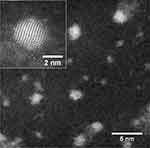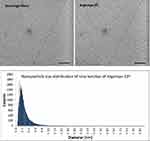Back to Journals » International Journal of Nanomedicine » Volume 17
Characterization of the Silver Nanoparticles in the Sovereign Silver® and Argentyn 23®, Bio-Active Silver Hydrosol™ Products [Letter]
Authors Qin N, Hemmes P, Mitchen K
Received 10 February 2022
Accepted for publication 17 February 2022
Published 7 March 2022 Volume 2022:17 Pages 983—986
DOI https://doi.org/10.2147/IJN.S355084
Checked for plagiarism Yes
Editor who approved publication: Prof. Dr. Anderson Oliveira Lobo
Nan Qin,1 Paul Hemmes,2 Kay Mitchen1
1Natural Immunogenics Corp, Sarasota, FL, 34243, USA; 2Paul Hemmes Consulting LLC, Austin, TX, USA
Correspondence: Kay Mitchen, Email [email protected]
View the original paper by Dr Kumar and colleagues
A Response to Letter has been published for this article.
Dear editor
Sovereign Silver and Argentyn 23 are the brand names of the Bio-Active Silver Hydrosol manufactured by Natural Immunogenics Corp (NIC). The products contain a mixture of positively charged silver ions and silver nanoparticles. In a 2020 publication by Kumar et al.,1 Sovereign Silver and Argentyn 23 were included as part of a “comparative evaluation of commercial colloidal silver products”. This publication concluded that there were no silver nanoparticles (AgNPs) present neither in the Sovereign Silver nor the Argentyn 23 products. This letter aims at providing a perspective omitted in the aforementioned publication and supporting the manufacturer’s marketing message as it relates to the presence of silver nanoparticles in its products, by providing detailed characterization using TEM and AFM.
There are numerous tools that can potentially be used for characterizing nanoparticles.2 While it is best to have multiple, orthogonal characterization techniques, there is an international consensus for transmission electron microscopy (TEM) being the “gold standard” technique for nanoparticle characterization. For example, the European Food Safety Authority (EFSA) requires two techniques to characterize the size and size distribution of nanomaterials in foods, one of which must be TEM and one of which the applicant may choose.3 Figure 1 shows representative TEM images of Sovereign Silver and Argentyn 23 products, which clearly demonstrate discrete and narrowly distributed silver nanoparticles. A particle size distribution histogram, obtained from nine batches of Argentyn 23 and no less than five images per batch, is also presented in Figure 1.
To corroborate the TEM findings, Atomic Force Microscopy (AFM) was also employed. The same 9 batches included for TEM analysis were analyzed by AFM and the results corroborate the TEM findings. A representative AFM height image and size distribution histogram are shown in Figure 2.
The TEM and AFM data presented in this letter provide a robust analytical dataset supporting the presence of AgNPs in the Sovereign Silver and Argentyn 23 products, directly contradicting the conclusion drawn by Kumar et al.1 Ultraviolet–visible spectroscopy (UV-Vis), the technology Kumar et al’s main conclusion is founded on, relies on the surface plasmon resonance (SPR) phenomenon of nanoparticles. Although sometimes useful with certain colloidal silver samples, UV-Vis is not a reliable method to determine the presence or absence of NPs, as the SPR changes or even disappears depending on NP size, surface chemistry, aggregation state among other factors.4–8 Because the Sovereign Silver and Argentyn 23 products contain a mixture of silver ions and AgNPs, it is expected that they would turn yellow when reducing agent of sodium borohydride was added. This experiment therefore cannot be used as an evidence for the absence of AgNPs, as suggested in the Kumar et al’s paper.
The paper also claimed the failed attempt to visualize silver nanoclusters as small as 0.8 nm in the Sovereign Silver and Argentyn 23 products using the Scanning Transmission Electron Microscope (STEM). Here we present STEM images obtained using a FEI Themis S/TEM operated at 200 kV in the high-angle annular dark-field STEM mode. The sub-nm silver clusters can be clearly visualized (Figure 3). More importantly, the atomic structure of the nanoparticles or clusters can be clearly seen, as shown in the insert of Figure 3. The d-spacing information can therefore be obtained to be 0.24 nm, agreeing with the (111) planes of metallic silver.
 |
Figure 3 Scanning Transmission Electron Microscopy (S/TEM) images of Sovereign Silver. |
In conclusion, this communication provides irrefutable scientific evidence of the presence of nanoparticles in both products, as well as corroboration of the particle size of the AgNPs in the Sovereign Silver and Argentyn 23 products. The characterization can be repeated using any commercially available Sovereign Silver and Argentyn 23 products. Detailed methods can be provided upon request.
Acknowledgment
The authors thanks Dr. Nicholas Rudawski for the operation of the FEI Themis S/TEM. The Research Service Centers of the Herbert Wertheim College of Engineering at the University of Florida is acknowledged for the use of the transmission electron microscope facilities.
Disclosure
Nan Qin is an employee at Natural Immunogenics Corp. Paul Hemmes is a consultant for Natural Immunogenics Corp. Ms Kay Mitchen is employed by Natural Immunogenics Corp, manufacturers of the Silver Hydrosol products. Her position in the company is Director of Regulatory Affairs and Quality. She oversees to the overall compliance of the company with the good manufacturing practices at the international level, which also includes ensuring all products’ claims are supported by scientific evidence. The authors report no other conflicts of interest in this communication.
References
1. Kumar A, Goia DV. Comparative analysis of commercial colloidal silver products. Int J Nanomed. 2020;15:10425–10434. doi:10.2147/IJN.S287730
2. MacCuspie RI. Chapter 4 - characterization of nanomaterials for NanoEHS studies. In: Hull MS, Bowman DM, editors. Nanotechnology Environmental Health and Safety.
3. Authority EFS. Guidance on the risk assessment of the application of nanoscience and nanotechnologies in the food and feed chain. EFSA J. 2018;9(5):2140.
4. Ishida R, Yamazoe S, Koyasu K, et al. Repeated appearance and disappearance of localized surface plasmon resonance in 1.2 nm gold clusters induced by adsorption and desorption of hydrogen atoms. Nanoscale. 2016;8(5):2544–2547. doi:10.1039/C5NR06373F
5. Raza S, Kadkhodazadeh S, Christensen T, et al. Multipole plasmons and their disappearance in few-nanometre silver nanoparticles. Nat Commun. 2015;6:8788. doi:10.1038/ncomms9788
6. Yang H, Wang Y, Chen X, et al. Plasmonic twinned silver nanoparticles with molecular precision. Nat Commun. 2016;7(1):12809. doi:10.1038/ncomms12809
7. Scholl JA, Koh AL, Dionne JA. Quantum plasmon resonances of individual metallic nanoparticles. Nature. 2012;483(7390):421–427. doi:10.1038/nature10904
8. Mendis P, de Silva RM, de Silva KMN, Wijenayaka LA, Jayawardana K, Yan M., Nanosilver rainbow: a rapid and facile method to tune different colours of nanosilver through the controlled synthesis of stable spherical silver nanoparticles. RSC Advances. 2016;6(54):48792-48799.
 © 2022 The Author(s). This work is published and licensed by Dove Medical Press Limited. The
full terms of this license are available at https://www.dovepress.com/terms.php
and incorporate the Creative Commons Attribution
- Non Commercial (unported, v3.0) License.
By accessing the work you hereby accept the Terms. Non-commercial uses of the work are permitted
without any further permission from Dove Medical Press Limited, provided the work is properly
attributed. For permission for commercial use of this work, please see paragraphs 4.2 and 5 of our Terms.
© 2022 The Author(s). This work is published and licensed by Dove Medical Press Limited. The
full terms of this license are available at https://www.dovepress.com/terms.php
and incorporate the Creative Commons Attribution
- Non Commercial (unported, v3.0) License.
By accessing the work you hereby accept the Terms. Non-commercial uses of the work are permitted
without any further permission from Dove Medical Press Limited, provided the work is properly
attributed. For permission for commercial use of this work, please see paragraphs 4.2 and 5 of our Terms.


